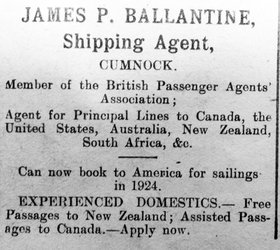by Roberta McGee
The Cumnock Chronicle Parish Reunions at Niagara Falls
The New History Of Cumnock - John Strawhorn - p184
In the 20th century two new floods of emigration, one in the first decade, the other after 1945, took more local people overseas. The Cumnock Chronicle has had a close and varied association with the emigration movement. In 1885 James P. Ballantine added to his printing and stationery business that of shipping and emigration agent. In 1955 Duncan Ballantine started an Overseas Readers' Column in the Chronicle and with the world his parish initiated that year a Cumnock Chronicle Parish reunion at Niagara Falls which became a regular annual event with sometimes as many as 500 guests with a Cumnock district connection.
The following article was reported in The Cumnock Chronicle on 4/8/2023
A document from the 1950s hidden in a dresser has revealed details of reunions held by former residents in the Cumnock area who emigrated to the USA and Canada.
The document, entitled 'Chronicle of the Byelaws of the Cumnock Chronicle Parish Reunion' was found by Donovan Moore, from the U.S. He revealed: "My great-grandmother moved to the United States from Scotland and I have recently inherited a few of her old dressers. My great-grandmother's name was Martha Gildea Hunter. The document states: "On Sunday, July 30, 1955, a group consisting of 75 loyal Scots held a reunion in the Queen Victoria Park, Niagara Falls, Ontario in honour of Mr. & Mrs. D. Maclean Ballantyne - Mr Ballantyne being editor and publisher of the Cumnock Chronicle, a weekly newspaper published in the south Ayrshire district of Scotland.
The people present on that occasion were drawn from both sides of the Canadian and American borders, but originally emigrated from the various home towns in said circulation area.
Since the gathering became such an unqualified social event, it was unanimously decided to set aside the last week in July of each year for similar purposes and that the current president Mr. James Thomson and secretary David Cunningham be instructed to draw up a set of bylaws covering all matters relevant to same.
The undernoted was presented at the second annual reunion in the Fox Head Hotel on 28 July 1956 and was adopted by acclamation
It then sets out byelaws, which confirmed that Mr. Ballantyne would become permanent honorary president. It also states that Membership would be open to any adult or a friend originating from any of the home towns where the Cumnock Chronicle reaches, Canadian or American. Descendants of parents from the area were also eligible for membership.
 |
Original Document
|
The aforementioned Duncan Maclean Ballantine was born at 51 Glaisnock Street, Cumnock on 15/11/1901 and died at Torrance Lodge Nursing Home, Hurlford in 1993. He was the Cumnock Chronicle Editor and Publisher.
The father of Duncan Maclean Ballantine was James Paterson Ballantine who was born on 11/7/1863 at Townhead, Cumnock.
Extract from The Cumnock Chronicle 1924
James Paterson Ballantine, the owner of the Cumnock Chronicle, was a printer-compositor, shipping & emigration agent. In 1885 he was first licenced as agent for The State Shipping Line and in subsequent years he was appointed agent for the principal shipping companies sailing from this country to all parts of the world. He conducted an extensive emigration business, sending young farm hands and domestics particularly to the Dominion of Canada and to Australia and New Zealand. At one time he was responsible for supplying almost the entire house staff of Scotch assistants to the Guelph Sanatorium in Ontario, when many years later, the writer, when visiting this institution in Guelph, met people whom Mr. Ballantine had sent out a generation or more earlier, all of them now in responsible positions. In connection with the emigration work, he paid two extensive visits to Canada, and as a result of his experiences on these occasions, he wrote and published a booklet on 'The Golden West' which was intended as a guide to prospective emigrants in the great farm and orchard lands of Nova Scotia, Quebec, Ontario, Manitoba, Saskatchewan, Alberta and British Columbia.
 |
Cumnock Chronicle 1924
|
Martha Gildea Hunter, to whom the document belonged, was born 26/12/1917 at Tower Street, Cumnock. Her father was Joseph Hunter, who was born in Portobello, and her mother was Martha Gildea, who was born in Dumbarton where they were married in 1907. Her grandfather was 'Pottery Joe' who worked at the nearby Cumnock Pottery.
Cumnock Connections - Family Tree (tribalpages.com)
The New History of Cumnock - John Strawhorn - p91
Joe's Brig was named after Joe Hunter ('Pottery Joe') who for many years entertained the Heckler's meetings with his wit, campaigning for a bridge to replace the stepping stones at the Greenholm.
 |
Joe’s Brig
|
On 17/7/1926 Martha Gildea Hunter's father Joseph sailed from Glasgow on the 'Caledonia', arriving in Philadelphia on 26/7/1926. His two oldest sons soon followed with James arriving in New York on 13/8/1928 and Joseph arriving on 2/9/1928. They were to join their father in Syracuse, which is in Onondaga County, New York. They were all reunited in May the following year when mother Martha and their siblings Alexander, Edward, Martha, Robert and Thomas arrived in New York aboard the 'Cameronia'. Another daughter Janet was born in New York in 1933.
Martha Gildea Hunter married Patrick J. Long and died 17/3/2010 in Syracuse, Onondaga, New York. Read more about Martha's life.
The Niagara Falls Reunions, which took place from 1955 onwards, were hugely popular for ex Cumnock folks. Did any of our members or their families ever attend them or perhaps have photographs they would like to share? We would love to see them.





.jpg)








